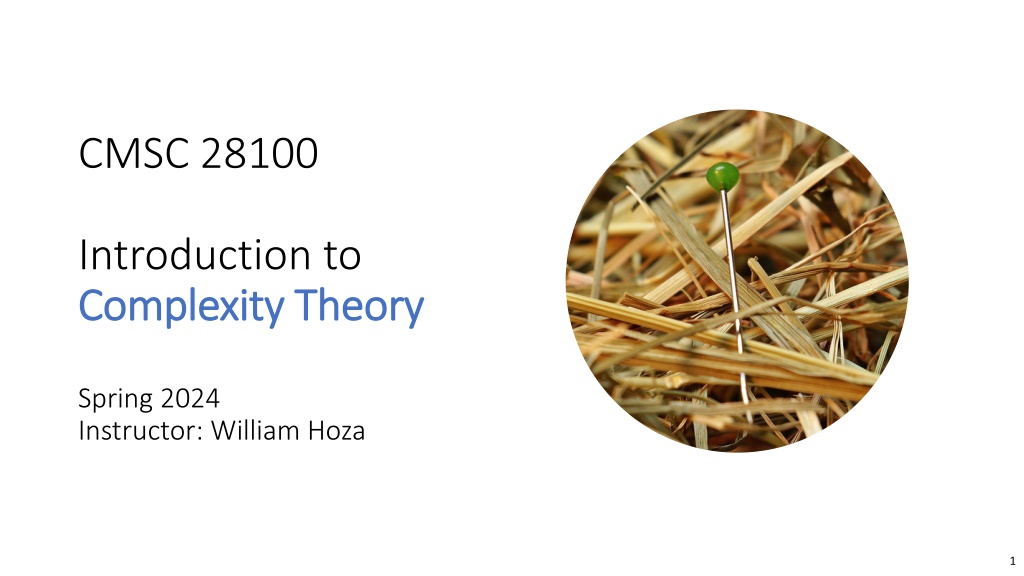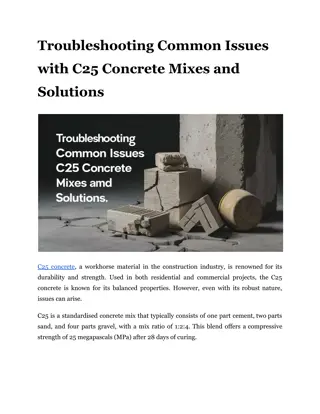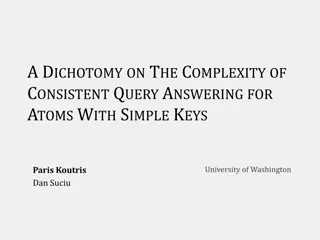
Exploring Complexity Theory in Quantum Computing
Delve into the fascinating world of Quantum Complexity Theory with a focus on BQP, Shor's Algorithm, NP-completeness, and the complexity of factoring integers. Discover how Factor could be a likely counterexample to the extended Church-Turing thesis and learn about the coNP complexity class.
Download Presentation

Please find below an Image/Link to download the presentation.
The content on the website is provided AS IS for your information and personal use only. It may not be sold, licensed, or shared on other websites without obtaining consent from the author. If you encounter any issues during the download, it is possible that the publisher has removed the file from their server.
You are allowed to download the files provided on this website for personal or commercial use, subject to the condition that they are used lawfully. All files are the property of their respective owners.
The content on the website is provided AS IS for your information and personal use only. It may not be sold, licensed, or shared on other websites without obtaining consent from the author.
E N D
Presentation Transcript
CMSC 28100 Introduction to Complexity Theory Complexity Theory Spring 2024 Instructor: William Hoza 1
Quantum complexity theory One can define a complexity class, BQP, consisting of all languages that could be decided in polynomial time by a fully-functional quantum computer The mathematical definition of BQP is beyond the scope of this course One can prove that BPP BQP PSPACE 2
Shors algorithm Recall FACTOR = ?,? ? has a prime factor ? ? Conjecture:FACTOR P Theorem (Shor s algorithm): FACTOR BQP FACTOR is a likely counterexample to the extended Church-Turing thesis! 3
Quantum computing and NP-completeness Recall: FACTOR NP (guess the factor) Shor s algorithm raises the question: Is FACTORNP-complete? If yes, then NP BQP, meaning that all NP-complete problems could be solved in polynomial time on a fully-functional quantum computer! 4
Complexity of factoring integers In most cases, if a language ? is in NP, then we can either prove ? P or we can prove that ? is NP-complete FACTOR is one of the rare exceptions to this rule Conjecture:FACTOR is neither in P nor NP-complete! 5
NP-hard 3-SAT NP-complete FACTOR is probably here. NP-intermediate NP PRIMES P 6
Complexity of factoring integers To explain why we expect that FACTOR is not NP-complete, we now introduce another complexity class, called coNP The definition of coNP is the same as the definition of NP, except that we swap the roles of yes and no 7
The complexity class coNP Let ? be a language Definition:? coNP if there exists a randomized polynomial-time Turing machine ? such that for every ? : If ? ?, then Pr ? accepts ? = 1 If ? ?, then Pr ? accepts ? 1 8
The complexity class coNP Let ? be a language, ? , and let ? = ? Fact: ? NP if and only if ? coNP coNP is the set of complements of languages in NP (This is why it is called coNP ) 9
The complexity class coNP Example: We say that a Boolean formula is unsatisfiable if it is not satisfiable Let 3-UNSAT = { ? ? is an unsatisfiable 3-CNF formula} Then 3-UNSAT coNP, because a satisfying assignment is a certificate showing that ? 3-UNSAT 10
FACTOR coNP FACTOR = { ?,? ? has a prime factor ? such that ? ?} Claim:FACTOR coNP Proof: The certificate for non-membership is the full prime factorization of ?, ?? and ?? s are distinct primes ?1 ?? i.e., ?1, ,??,?1, ,?? where ? = ?1 Since ?? 2, we have ? log?, so the certificate has poly size Verification: Confirm that each ?? is prime (PRIMES P); confirm that ? ??; and confirm that the smallest ?? is bigger than ? really is equal to ??? 11
The complexity class NP coNP We have shown that FACTOR NP and FACTOR coNP FACTOR NP coNP ? NP coNP means that for every instance, there is a certificate: a certificate of membership for YES instances and a certificate of non-membership for NO instances 12
The NP vs. coNP problem Conjecture: NP coNP The statement NP = coNP would mean that for every unsatisfiable circuit, there is some short certificate I could present to prove to you that a circuit is unsatisfiable That sounds counterintuitive! But we don t really know 13
PSPACE NP coNP FACTOR NP coNP P 14
NP-completeness and NP coNP Fact: Assuming NP coNP, there are no NP-complete languages in NP coNP (Proof: Exercise) This gives us evidence that FACTOR is not NP-complete 15
coNP-hard NP-hard NP coNP FACTOR NP coNP P 16
Quantum computing is not a panacea FACTOR BQP, but FACTOR is probably not NP-complete In fact, it is conjectured that NP BQP In this case, even a fully-functional quantum computer would not be able to solve NP-complete problems in polynomial time Even quantum computers have limitations 17
NP-hard 3-SAT EXP NP-complete NP FACTOR BQP P 18
Which problems Which problems can be solved can be solved through computation? through computation? 19
Limitations of quantum computers We have developed several techniques for identifying hardness Undecidability EXP-completeness NP-completeness Those techniques are all still applicable even in a world with fully- functional quantum computers! Complexity theory is intended to be future-proof / timeless 20
Which problems Which problems can be solved can be solved through computation? through computation? 21
Complexity theory: Complexity theory: The study of The study of computational resources computational resources 22
Computational resources: Fuel for algorithms TIME RANDOMNESS SPACE COMMUNICATION QUANTUM PHYSICS PARALLELISM 23
Sublinear-space computation Can we solve any interesting problems using ? ? space? The one-tape Turing machine is the not the right model of computation for studying sublinear-space algorithms 24
Sublinear-space computation 1 1 0 1 1 Read-only input tape 0 0 1 Read-write work tape 25
The complexity class SPACE ? Let ? be a language and let ?: be a function (space bound) Definition:? SPACE ? if there is a two-tape Turing machine ? such that: ? decides ? ? never modifies the symbols written on tape 1 Whenever ? reads a blank symbol on tape 1, the tape 1 head moves to the left We have ??? = ? ? ? , where ??? is the maximum ? such that the tape 2 head visits cell ? during the computation of ? on ? for some ? ? 26
The complexity class L Exercise: PSPACE = ?SPACE ?? Definition:L = SPACE log? L is the set of languages that can be decided in logarithmic space 27
BALANCED L BALANCED = ? {0,1} ? has equal numbers of zeroes and ones Claim:BALANCED L Proof sketch: Given ? {0,1}?: Count the number of ones in ? These counters are only log? bits each! Count the number of zeroes in ? Check whether the two counts are equal 28
L P Exercise: Show that L P (Similar to the proof that PSPACE EXP) 29
EXP PSPACE NP P L 30
The L vs. P problem We expect that L P, but we don t know how to prove it L = P would mean that every efficient algorithm can be modified so that it only uses a tiny amount of work space 31
L vs. P vs. NP vs. PSPACE L P NP PSPACE What we expect: All of these containments are strict What we can prove: At least one of these containments is strict: Theorem: L PSPACE 32
Nondeterministic log space computation We define NL to be the class of languages that can be decided by a nondeterministic log-space Turing machine Equivalently: NL is the class of languages for which membership can be verified in logarithmic space with the extra requirement that the verifier can only read the certificate one time from left to right 33
Two surprises about NL We expect that P NP. However, in the space complexity world Savitch s Theorem: NL SPACE log2? We expect that NP coNP. However, in the space complexity world Immerman-Szelepcs nyi Theorem: NL = coNL 34




